Wikipedia:Picture of the day/June 2018
|
Featured picture tools: |
These featured pictures, as scheduled below, appeared as the picture of the day (POTD) on the English Wikipedia's Main Page in June 2018. Individual sections for each day on this page can be linked to with the day number as the anchor name (e.g. [[Wikipedia:Picture of the day/June 2018#1]] for June 1).
You can add an automatically updating POTD template to your user page using {{Pic of the day}} (version with blurb) or {{POTD}} (version without blurb). For instructions on how to make custom POTD layouts, see Wikipedia:Picture of the day.
June 1

|
Schwäbisch Hall is a town in the German state of Baden-Württemberg and capital of the district of Schwäbisch Hall. The town is located in the valley of the Kocher river in the north-eastern part of Baden-Württemberg. Photograph: Petar Milošević
Recently featured: |
June 2

|
Pachygrapsus marmoratus is a species of crab that lives in the Black Sea, the Mediterranean Sea, and parts of the Atlantic Ocean. It is dark violet brown, with yellow marbling, and with a body up to 36 millimetres (1.4 in) long. It is an omnivore, feeding on algae and various animals including mussels and limpets. Photograph: Petar Milošević
Recently featured: |
June 3

|
A Day (1904), a painting by the Lithuanian artist and composer Mikalojus Konstantinas Čiurlionis (1875–1911). Čiurlionis contributed to symbolism and Art Nouveau and was representative of the fin de siècle epoch. He has been considered a pioneer of abstract art in Europe. During his short life, he composed about 400 pieces of music and created about 300 paintings. The majority of his paintings are held by the M. K. Čiurlionis National Art Museum in Kaunas, Lithuania. Painting: Mikalojus Konstantinas Čiurlionis
Recently featured: |
June 4

|
The black-tailed godwit (Limosa limosa) is a large, long-legged, long-billed shorebird first described by Carl Linnaeus in 1758. There are three subspecies, all with orange head, neck and chest in breeding plumage and dull grey-brown winter coloration, and distinctive black and white wingbar at all times. Its range stretches from Iceland through Europe and central Asia during the breeding season, wintering in areas as diverse as the Indian subcontinent, Australia, western Europe, and west Africa. The species is more likely to be found inland and on freshwater than the similar bar-tailed godwit. The world population is estimated to be 634,000 to 805,000, and the species is classified as Near-Threatened. Photograph: Andreas Trepte
Recently featured: |
June 5

|
The Surrender of Breda is a painting by the Spanish Golden Age painter Diego Velázquez. Completed during the years 1634–1635, it depicts the conclusion of the Siege of Breda (1624–1625) and was inspired by Velázquez's visit to Italy with Ambrogio Spinola, the Genoese general who conquered the city. Now held at the Museo del Prado in Madrid, it is considered one of Velázquez's best works. Painting: Diego Velázquez
Recently featured: |
June 6

|
Taagepera Church is a church built in 1764 on a hill above the village of Taagepera, southern Estonia. Photograph: Ivar Leidus
Recently featured: |
June 7

|
Self-Portrait with Halo and Snake is an 1889 oil on wood painting by French artist Paul Gauguin, which represents his late Brittany period in the fishing village of Le Pouldu in northwestern France. It shows Gauguin against a red background with a halo above his head and apples hanging beside him as he holds a snake in his hand while plants or flowers appear in the foreground. The religious symbolism and the stylistic influence of Japanese wood-block prints and cloisonnism are apparent. The work is one of more than 40 self-portraits he completed. It is held at the National Gallery of Art in Washington, D.C. Painting: Paul Gauguin
Recently featured: |
June 8
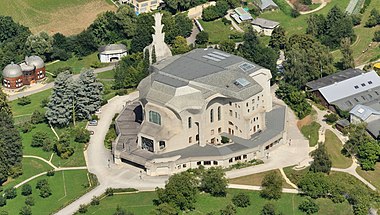
|
An aerial view of the Goetheanum, a center for anthroposophy located in Dornach, Switzerland. The building was designed by Rudolf Steiner and named after Johann Wolfgang von Goethe. It includes two performance halls, gallery and lecture spaces, a library, a bookstore, and administrative spaces for the Anthroposophical Society; neighboring buildings house the Society's research and educational facilities. Conferences focusing on themes of general interest or directed toward teachers, farmers, doctors, therapists, and other professionals are held at the center throughout the year. Photograph: Taxiarchos228
Recently featured: |
June 9

|
Carl Nielsen (1865–1931) was a Danish musician, conductor and violinist, widely recognized as his country's most prominent composer. Initially playing in a military band before attending the Royal Danish Academy of Music in Copenhagen, he premiered his Op. 1, Suite for Strings, in 1888, at the age of 23. His early music was inspired by composers such as Brahms and Grieg, but he soon developed his own style. By the time of his death, he had produced 419 known works; some of these, such as his opera Maskarade (1906), have become integral to Denmark's national heritage. Photograph: Georg Lindstrøm; restoration: Adam Cuerden
Recently featured: |
June 10
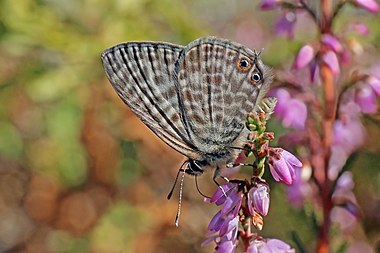
|
A male Lang's short-tailed blue (Leptotes pirithous) in the Nature Park of Alvão, Portugal. This small butterfly has an expansive range, covering southern Europe along the Mediterranean coast through Asia Minor and most of Africa and Madagascar, where it is found primarily in varied wasteland, cultivated areas and gardens. Photograph: Charles J. Sharp
Recently featured: |
June 11

|
A Norwegian rigsdaler banknote, dated 1807 and in the denomination of five rigsdalers. The 1807 issue, in denominations of 1, 5, 10 and 100, was the first issue of rigsdaler banknotes in more than a century, following the 1695 issue. In 1816, following the establishment of a union between Sweden and Norway, the rigsdaler was renamed the speciedaler and became the standard unit of currency in Norway. Banknote: Kingdom of Norway (courtesy of the National Numismatic Collection, National Museum of American History)
Recently featured: |
June 12

|
Cosimo I de' Medici (1519–1574) was the Duke of Florence from 1537 until 1569, when he became the first Grand Duke of Tuscany. Part of the junior branch of the Medici dynasty, Cosimo came to power after the assassination of Alessandro de' Medici marked the end of the senior branch's rule. Although several hoped to rule through the 17-year-old Cosimo, he proved strong-willed, astute and ambitious. Over time, he established himself as an authoritarian ruler who backed the military while simultaneously serving as a lavish patron of the arts. His descendants ruled Florence for much of two centuries, ending with the death of Gian Gastone de' Medici in 1737. Painting: Bronzino
Recently featured: |
June 13

|
Old Monkey with Cherry in Autumn, a color on silk painting completed by the Japanese artist Hashimoto Kansetsu in 1938. Hashimoto (1883–1945) was active in Kyoto, where he produced a number of nihonga works inspired by Chinese scenery or Chinese classical literature. His former residence is now a museum dedicated to his work. Painting: Hashimoto Kansetsu
Recently featured: |
June 14
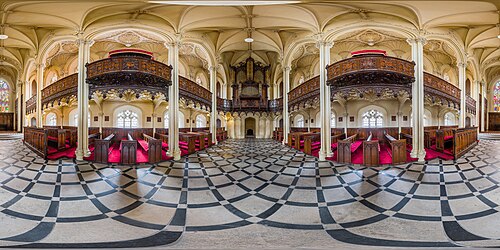
|
|
The interior of the Chapel Royal in Dublin Castle (view in 360° panoramic viewer), which has been called one of the finest Gothic Revival interiors in Ireland. Designed by Francis Johnston and constructed over a period of seven years, this was the official Church of Ireland chapel of the Household of the Lord Lieutenant of Ireland from 1814 until the creation of the Irish Free State in 1922. In 1943, after years of disuse, it was acquired by the Irish Army and made a Catholic church. It has been deconsecrated since 2015. Photograph: David Iliff
Recently featured: |
June 15

|
The Seal of Arkansas, as depicted in the 1876 book The State Arms of the Union. Adopted in 1864, it contains the Angel of Mercy, the Sword of Justice and the Goddess of Liberty, as well as a bald eagle with a bundle of arrows in one claw and an olive branch in the other; a scroll at the bottom is inscribed Regnant Populi. The seal was modified in 1907; this revised design remains in use today. Illustration: Henry Mitchell; restoration: Andrew Shiva
Recently featured: |
June 16

|
Ruth is the title character of the Biblical Book of Ruth, which tells how she and her mother-in-law Naomi travelled from Moab to Judah. Arriving in Bethlehem in a state of poverty, Naomi sent Ruth to speak to a prosperous relative named Boaz and become a gleaner in his fields. That evening, Ruth put herself in his power, and Boaz later reclaimed the estate of her deceased father-in-law. Boaz and Ruth became great-grandparents of David, King of Israel. Shown here is Julius Schnorr von Carolsfeld's painting Ruth in Boaz's Field, depicting Ruth as a gleaner with Boaz. Completed in 1828, the work is now in the National Gallery in London. Painting: Julius Schnorr von Carolsfeld
Recently featured: |
June 17

|
The Leaning Tower of Pisa is the freestanding bell tower of the Cathedral of Pisa, Italy. The third oldest structure in the city's Square of Miracles, it is known worldwide for its unintended tilt. The tower's tilt began during construction in the 12th century, caused by an inadequate foundation on ground too soft on one side to properly support the structure's weight. The tilt gradually increased until the tower was stabilized (and the tilt partially corrected) by efforts in the late 20th and early 21st centuries. The tower, which measures 55.86 metres (183.27 feet) from the ground on the low side and 56.67 metres (185.93 feet) on the high side, has been listed as a UNESCO World Heritage Site since 1987. Photograph: Saffron Blaze
Recently featured: |
June 18

|
A 15-cent banknote depicting Union Army generals William Tecumseh Sherman and Ulysses S. Grant, dated 1866 and intended as part of the fractional currency introduced to the United States following the American Civil War. As the portraits of Sherman and Grant for this note were being finalized, Representative Martin Russell Thayer pushed forward legislation specifically stating "that no portrait or likeness of any living person hereafter engraved, shall be placed upon any of the bonds, securities, notes, fractional or postal currency of the United States". As such, the Sherman-Grant note was never issued; examples of this note exist only as specimens. Banknote: Bureau of Engraving and Printing (courtesy of the National Numismatic Collection, National Museum of American History)
Recently featured: |
June 19

|
New York State Route 199, seen here east of Hammertown, is a 30.91-mile-long (49.74 km) state highway located in the Hudson Valley of the U.S. state of New York. From its west end in Ulster County north of Kingston, it crosses the Kingston–Rhinecliff Bridge over the Hudson River, crossing northern Dutchess County to its east end near Millerton. Photograph: Daniel Case
Recently featured: |
June 20
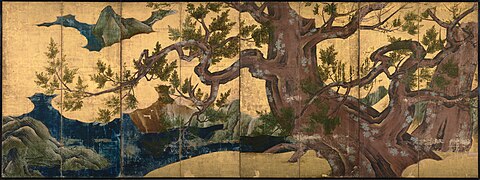
|
|
Cypress Trees is a polychrome-and-gold folding screen attributed to the Japanese painter Kanō Eitoku (1543–1590), one of the most prominent patriarchs of the Kanō school of Japanese painting. The painting dates to the Azuchi–Momoyama period. Now in Tokyo National Museum, it has been designated a National Treasure of Japan. Painting: Kanō Eitoku
Recently featured: |
June 21

|
A portrait of a female bare-faced curassow (Crax fasciolata), taken at the Pantanal in Brazil. This species of bird in the family Cracidae is found in eastern-central and southern Brazil, Paraguay, eastern Bolivia, and extreme northeast Argentina. Its natural habitats are tropical and subtropical dry and moist broadleaf forests. Photograph: Charles J. Sharp
Recently featured: |
June 22
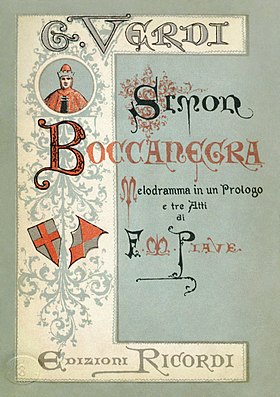
|
The cover of the first edition libretto for the 1881 revision of Simon Boccanegra. This opera with a prologue and three acts was written by Giuseppe Verdi to an Italian libretto by Francesco Maria Piave, based on Antonio García Gutiérrez's play Simón Bocanegra (1843). First performed at Teatro La Fenice in Venice in 1857, it received a generally poor popular response and had dropped out of favour by 1866. Verdi prepared a revised edition more than a decade later, with text changes by Arrigo Boito. This version was first performed at La Scala in Milan in 1881, and remains the most frequently performed today. Illustration: Uncredited; restoration: Adam Cuerden
Recently featured: |
June 23

|
|
Man Writing a Letter and Woman Reading a Letter, two oil paintings on panel made by Dutch artist Gabriël Metsu in the 1660s. The former shows a young man sitting in front of an open window, writing a letter with a quill pen, while the latter depicts a woman reading a letter, which the work's symbolism suggests is a romantic one. These paintings are generally considered companion pieces, with the man writing the letter that the woman is reading. They have been held—and twice stolen—as a pair since at least the early 18th century, when the works were owned by collector Hendrick Sorgh of Amsterdam. They were donated to the National Gallery of Ireland in 1987. Painting: Gabriël Metsu
Recently featured: |
June 24

|
Francine Jordi (b. 1977) is a Swiss pop singer. After winning the German Grand Prix der Volksmusik in 1998 with the song "Das Feuer der Sehnsucht", Jordi found success in Switzerland. In 2002, she represented Switzerland at the Eurovision Song Contest in Tallinn with a French language song "Dans le jardin de mon âme". Photograph: Manfred Werner |
June 25

|
A view of the Japanese destroyer Yamakaze through the periscope of the submarine USS Nautilus, after being torpedoed approximately 60 nautical miles (110 km) southeast of Yokosuka, Japan. The Shiratsuyu-class destroyer, which had been traveling independently from Ōminato towards the Inland Sea, sank with all hands. Yamakaze had previously been involved in battles at Tarakan (1942), Java Sea (1942), and Midway (1942), sinking one submarine and assisting in the sinking of two ships. Photograph: United States Navy |
June 26

|
Sagittarius (Latin for the archer) is one of the 88 modern constellations. Commonly represented as a centaur drawing a bow, it lies between Scorpius and Ophiuchus to the west and Capricornus to the east. Among its features are Epsilon Sagittarii, the brightest star in the constellation, and the center of the Milky Way, lying in its westernmost. Sagittarius has been recognized since the time of the ancient Babylonians and Greeks, and today constitutes one of the twelve constellations of the zodiac. Here, Sagittarius is shown together with Corona Australis, Microscopium, and Telescopium. This illustration by Sidney Hall was included in Urania's Mirror, a set of 32 astronomical star chart cards first published in 1824. Illustration: Sidney Hall; restoration: Adam Cuerden |
June 27

|
The Lion of Al-lāt is an ancient statue which adorned the temple of pre-Islamic goddess al-Lāt in Palmyra, Syria. On 27 June 2015, it was severely damaged by the Islamic State of Iraq and the Levant after they captured Palmyra. The statue was eventually removed to the National Museum of Damascus, underwent reconstruction works, and now stands again. Photograph: Mappo
Recently featured: |
June 28
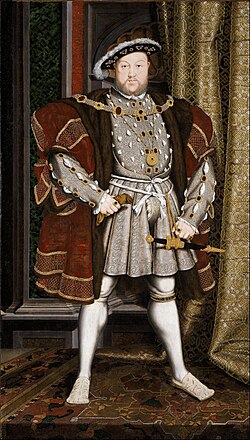
|
Henry VIII of England (1491–1547) was King of England from 1509 until his death. Henry was the second Tudor monarch, succeeding his father, Henry VII. Perhaps best known for his six marriages, his disagreement with the Pope on the question of annulment led Henry to initiate the English Reformation, separating the Church of England from papal authority and making the English monarch the Supreme Head of the Church of England. He also instituted radical changes to the English Constitution, expanded royal power, dissolved monasteries, and united England and Wales. In this, he spent lavishly and frequently quelled unrest using charges of treason and heresy. Painting: Portrait of Henry VIII, workshop of Hans Holbein the Younger
Recently featured: |
June 29
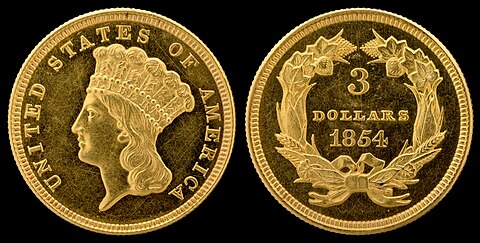
|
|
The three-dollar piece was a gold coin produced by the United States Mint from 1854 to 1889. The coin was designed by Mint Chief Engraver James B. Longacre. Its obverse bears a representation of Lady Liberty wearing a headdress of a Native American and the reverse a wreath of corn, wheat, cotton, and tobacco. Although over 100,000 were struck in the first year, the coin saw little use. The piece was last struck in 1889, and Congress ended the series the following year. Coin: United States Mint; photograph: Jaclyn Nash/National Numismatic Collection
Recently featured: |
June 30

|
|
Barge Haulers on the Volga is an oil painting on canvas completed between 1870 and 1873 by the realist artist Ilya Repin. It depicts eleven men physically dragging a barge on the banks of the Volga River. Depicting these men as at the point of collapse, the work has been read as a condemnation of profit from inhumane labor. Barge Haulers on the Volga drew international praise for its realistic portrayal of the hardships of working men, and launched Repin's career. It has been described as "perhaps the most famous painting of the Peredvizhniki movement [for]....its unflinching portrayal of backbreaking labor". Today, the painting hangs in the Russian Museum in Saint Petersburg. Painting: Ilya Repin
Recently featured: |
Picture of the day archives and future dates
